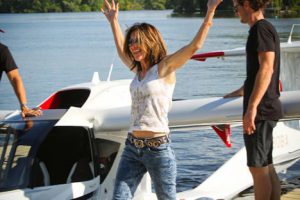MIKE SATREN – Attendees at the annual Experimental Aircraft Association’s weeklong AirVenture last week celebrated the accomplishments of world-renowned aircraft designer Burt Rutan.
It marked the 40th anniversary of Rutan’s leading-edge VariEze composite light aircraft with a small canard wing on the front and a pusher-prop engine on the rear. This pusher-style aircraft design with the little wing on the front and the large wing in the rear turned heads in the aviation world. His subsequent designs both refined that initial concept and then radically departed from it as he constantly tested new ideas in the hot and dusty petri dish of Mojave, Calif., which he filled with top-notch aeronautical engineers who all wanted to be a part of something big.
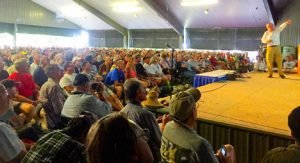
Rutan, who now resides in Coeur d’Alene with his wife, Tonya, had been working 12 to 14 hours a day, seven days a week for months on his 47th unique airplane design, which he calls SkiGull, trying to complete and test it to bring to Oshkosh this year. With a very tight time frame ahead and only a couple weeks to go until EAA’s AirVenture, an FAA inspection scheduling glitch and then a component crack made it clear that the flight of SkiGull to Oshkosh would not happen this year.
The next day, Rutan slept for hours, realizing finally that he was exhausted. His primary co-builder, Dan Woodward of Athol, did the same. Brent Regan – who had been fabricating the engine mount and fitting the engine, the electrical system, the avionics, the pneumatic systems and more – soldiered on and completed his tasks in the days leading to Oshkosh, making the work of finishing and flight testing SkiGull closer than ever. Rutan plans to carry on those tasks and fly SkiGull sometime in August or September.
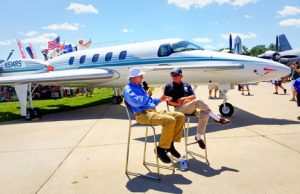
THE TRIP
The largest of Rutan’s canard pusher designs, the Beechcraft Starship, is a business-class airplane powered by two Pratt & Whitney Canada PT-6 turboprop engines. Rutan’s friend Robert Scherer of Aspen, Colo., flew his Starship to Coeur d’Alene and departed with Burt, Tonya, Bill Whittle, Brent Regan, Dan Woodward and his son, Kyle, on Monday, July 20, for a three-hour nonstop flight to Oshkosh, arriving during the daily airshow. Other Coeur d’Alene SkiGull team members, Trevor Budge and his friend, Amy Orchard, flew the airlines, while Dale and Jackie Martin of Lewiston drove to Oshkosh.
For four subsequent days, Rutan held interviews, gave talks, and offered details that enthralled EAA AirVenture crowds.
FIGHTER JET FEVER
Expounding on the VariEze at the Oshkosh event, Rutan went back to his days as a contract Air Force flight test engineer on the F4 Phantom and relayed his desire to build a personal aircraft with the look and feel of a fighter jet. Taking his inspiration from the Swedish SAAB 37 Viggen with a canard wing on the front and also the North American B-70 Valkyrie strategic bomber, also with a canard wing, Rutan designed and built a wood fuselage, metal wing tandem two-seat hotrod he called the VariViggen. Rutan flew his VariViggen in the 1975 film “Death Race 2000,” when the director wanted an X-wing fighter-looking airplane as part of the action. Rutan also flew his VariViggen to St. Louis International Airport, where McDonnell built the F4 Phantoms, to show it off.
Taking a McDonnell flight test pilot in the back seat, Rutan asked the tower for departure clearance and the tower controller, clearly enamored, asked Rutan if he could do a flyby after takeoff. Rutan asked how close and the tower operator said, “At your discretion.” That’s like telling Muhammad Ali to pull his punch just in front of your nose, at his discretion.
As Rutan put the VariViggen into a knife-edge turn right in front of the tower windows, partially circling the tower, his passenger covered up his insignia, not knowing about the “at your discretion” clearance Rutan had been given and not wanting to be busted for carelessness.
WORLD RECORD TEAMWORK
Later while trying to fix a number of performance shortcomings of the VariViggen, Rutan discovered the benefits of composites, which had been used by European sailplane makers for some time. Working on layups afforded Rutan the opportunity to perfect the fiberglass over foam core construction techniques which he uses even today. That construction process also made the VariEze a very simple airplane to build, unlike the very complex VariViggen. Rutan also changed out the Volkswagen engine in the proof-of-concept VariEze for the aircraft certified Continental O-200, vastly improving reliability for his homebuilders.
AirVenture hosts put Burt together with his former fighter pilot brother, Dick, for several talks, which further captivated audiences. These two brothers could not be more different. Burt is the analytical engineer while Dick is, well, a fighter pilot. Dick also test flew a number of Burt’s designs including the Voyager, which was a collaboration between Burt, Dick and Jeana Yeager, who accompanied Dick in their famous nonstop, non-refueled flight around the world Dec. 14-23, 1986.
One time Dick complained to Burt about the handling characteristics of Voyager as more and more fuel was added, showing it to be dynamically unstable at heavy weights. Burt reminded Dick that the design criteria of Voyager was to make it around the world and not necessarily to be easy to fly. They were, by the way, attempting to double the nonstop record held at that time by a crew of a B-52, which had made it just halfway around the world.
On the day of the world flight takeoff, Dec. 14, 1986, Voyager was filled to the agreed-upon level plus more at Dick’s request, making fuel 72 percent of its total takeoff weight. The wings drooped so low that they dragged on the 3-mile runway at Edwards Air Force Base for most of the takeoff run. After slowly ascending into ground effect and then climbing out, both wingtips fell off, having scraped the ground for so long and grinding off material. Fortunately, no fuel leaked. The banter between these brothers was priceless, and as is usual at Oshkosh, more likely to happen there than anywhere.
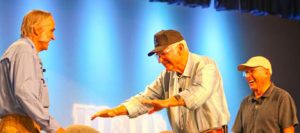
MAGIC WITH THE MELVILLS
Rutan hired Mike and Sally Melvill in 1974 after Mike had completed his VariViggen from the plans he had bought, the first person to do so after Rutan built his prototype. Rutan wanted Melvill to come work for him, providing builder support, and then found out that Sally was a bookkeeper (and a pilot) so he offered them a combined $20,000 annually, telling them they could divide it up themselves as they saw fit. He wanted both of them.
Once, when Dick was flying a 33-hour distance record, he reported a right brake failure. Quickly Rutan got Sally in an airplane on the runway and told her to taxi medium fast (half fast?) but to refrain from using her rudders and brakes. Meanwhile, Rutan rode a motorcycle just off the right wingtip while Mike rode on the back and grabbed hold of the wing. Then Rutan would slow up a little, turning the airplane to the right and speed up a little turning it to the left. Satisfied that they could pull this off, they told Dick what to do and how they intended to help him land straight.
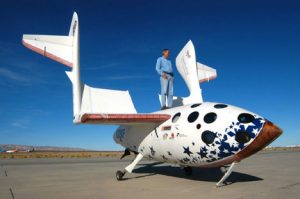
THE FINAL FRONTIER
For years when asked what was his favorite design, Rutan would say, “The next one,” which was always a secret until it was unveiled ready to fly. That is, until SpaceShipOne.
“After SpaceShipOne, I quit saying the next one,” Rutan said.
Dismayed by the lack of NASA manned flight research and inspired by the Ansari X Prize challenge, Rutan found a willing backer in Paul Allen to fund Rutan’s ideas into a workable spaceship. But Rutan also needed a launch vehicle. Fortunately he had plans for both. Using the unconventional method of dropping the spaceship from between the twin-hulled White Knight launch vehicle, Rutan set to work.
For the descent from its apogee (high point), he came up with the idea of “feathering” the space ship by hinging its tail upward, allowing a level and stable attitude that also kept its speed under control while re-entering the atmosphere. Then, when closer to ground, the pilot would unfeather the space ship and land conventionally. During these tests and flights including one of the two that would win the $10 million Ansari X Prize in 2004, Melvill was the test pilot/astronaut. But his first flight into space was a doozy.
Unknown at the time, there was some rocket thrust asymmetry that required rudder inputs and as Melvill tried to shoot straight up in his SpaceShipOne, it canted first one way hard then upon correction the other way hard. Melvill kept his cool and finally saw what astronauts see: black sky. He only hoped that he was high enough to make it into space, officially. He made it by just a little bit, becoming the first civilian astronaut. After the flight, the alignment error was caught and corrected. Rutan had a vested interest in the safety of his crew.
“Mike Melvill is my best friend,” he said.
NO MORE RUNWAYS
After giving his PowerPoint presentation introducing the world to his 47th (and last, he claims) aircraft design named the SkiGull, someone asked, “After so many successes in aircraft design, how is it that you’re such a failure at retirement?”
After everyone laughed, Rutan kind of skirted the answer but gave some background on SkiGull’s development idea. First he wanted to build a composite wing-ship, a ground-effect controllable (i.e. just off the water) aircraft/boat that could get from Coeur d’Alene to St. Maries fast. Brent Regan said Rutan actually meant to build a submarine first. He had been to Russia decades ago and seen the huge cargo wingships on the Black Sea intended to deliver troops, vehicles and tanks from shore to shore. Then he decided that if he added wing tips, he could fly to other nearby lakes in North Idaho.
As time went on he expanded SkiGull’s scope to its current mission, landable on water, snow, grass and hard surfaces. This aircraft is capable of exploring the world off-airport, flying two people plus baggage at 160 knots, above 20,000 feet if needed and totally resistant to saltwater corrosion. Oh, and be able to cross the California to Hawaii leg, which is the world’s longest overwater stretch. That’s because SkiGull is a motor glider, as was the Voyager.
Whether at 72 years old he is up to it, so he says, Rutan talks about his Walter Mitty idea of exploring the world clear of runways.
TONYA’S TRIUMPH
Clearly proud of his wife, Tonya, Rutan on several occasions asked his audiences for a show of hands how many held single-engine seaplane ratings. A decent smattering of hands would go up. Then he would say, “How many of you don’t have a single engine landplane rating?” Only Tonya’s hand remained.
After flying backseat first as his girlfriend and then as his wife, Tonya has at least 1,000 hours in the air with him. Last year she determined to learn to fly – and with the help of Mike Kincaid and Glen Smith, earned her private pilot license solely in a seaplane. Almost no one does that. Instead, one learns to fly a land plane to get a pilot’s license and then he or she will add the seaplane rating sometime later. Even now Tonya is working on her land plane rating with a tailwheel endorsement.
After leaving Oshkosh and texting Rutan to say how much my wife, Jill, and I enjoyed the event, he replied, “It was the best Oshkosh ever.”
That is how so many of his admirers hoped he would feel.
Text and photos courtesy of Mike Satren

